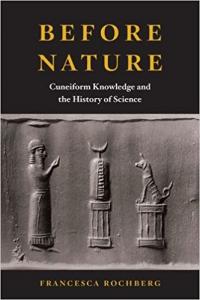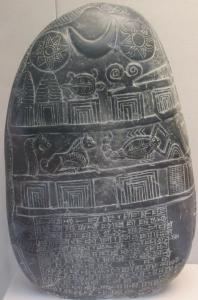 I have started reading a new book recommended by John Walton: Before Nature: Cuniform Knowledge and the History of Science by Francesca Rochberg. The book is quite academic and rather expensive (not light reading by any stretch of the imagination). However, it is interesting and very relevant to our ongoing discussions of the interaction between science and scripture. The Old Testament was written into an ancient Near Eastern culture where the identification of “natural” and the division between supernatural and natural was quite different from our modern western understanding. The title, Before Nature, reflects the fact that it is an anachronism to assign our understanding of ‘nature’ to the cultures that gave rise to the cuneiform texts through which we know ancient Mesopotamian culture from Sumeria to Babylon.
I have started reading a new book recommended by John Walton: Before Nature: Cuniform Knowledge and the History of Science by Francesca Rochberg. The book is quite academic and rather expensive (not light reading by any stretch of the imagination). However, it is interesting and very relevant to our ongoing discussions of the interaction between science and scripture. The Old Testament was written into an ancient Near Eastern culture where the identification of “natural” and the division between supernatural and natural was quite different from our modern western understanding. The title, Before Nature, reflects the fact that it is an anachronism to assign our understanding of ‘nature’ to the cultures that gave rise to the cuneiform texts through which we know ancient Mesopotamian culture from Sumeria to Babylon.
John Walton has argued at length (see Lost World of Genesis One, Lost World of Adam and Eve, and, on a more academic level, Genesis 1 as Ancient Cosmology) that Genesis is written for us, but it isn’t written to us. The context of the original audience and author can and should help inform our understanding of the message.
 Rochberg’s emphasis is very different (her focus is cuneiform texts from Mesopotamia not Israel or Scripture) – but the point that ancient documents reflect and ancient understanding of the world is an important one. The ancient Israelite culture reflects the same basic understanding (Abram from Ur, the exile in Babylon alongside other contacts in the region). Genesis is both written into this culture and against this culture. We understand the text more completely when we understand the context.
Rochberg’s emphasis is very different (her focus is cuneiform texts from Mesopotamia not Israel or Scripture) – but the point that ancient documents reflect and ancient understanding of the world is an important one. The ancient Israelite culture reflects the same basic understanding (Abram from Ur, the exile in Babylon alongside other contacts in the region). Genesis is both written into this culture and against this culture. We understand the text more completely when we understand the context.
The Sumerians and Babylonians knew quite a lot about the world and the cosmos. Tablets chart the position of stars and the timing of lunar eclipses. The scholars were observant and able to make sense of their observations. We’ve recently discovered that they recorded trigonometric tables ca. 1700 BC, more than a thousand years before the Greeks (previously thought to be first). This doesn’t mean that cuneiform texts recording information about the world reflect a view of ‘nature’ similar to ours.
Rochberg writes:
It seems to me that the world-picture in which the cuneiform scribe operated was constructed of other structures, other scaffolding, to use a metaphor of Wittegenstein’s, than that which we call nature. The scaffolding of the cuneiform scribes’ world might be described in terms of divine design, as in the expressions “the designs of heaven and earth” (uṣurāt šamê u erṣeti) or “the enduring designs of the gods (uṣurāt ilī kīnāti), but these expressions do not convey notions of a material essence or an independent rationality apart from divine will. (p. 29)
This doesn’t mean that the ancient Near Eastern cultures play no role in an understanding of the history of science – but it does mean that we need to read them with a mind attuned (insofar as we are able) to the ancient context. Rochberg continues:
I maintain that there was a long-lived learned Assyro-Babylonian tradition of knowledge about the phenomena that bears relation to the history of science regardless of the absence of a conscious category of nature around which to focus its epistemic tradition. (p. 30)
She goes on later to observe that classifying these ancient ways of thought using our term ‘science’ does not really capture the essence of their concerns. The cuneiform scribes were not interested in what we call ‘natural science’ or ‘natural knowledge.’ “That the scribes were not directed toward a description of nature puts the entirety of the cuneiform knowledge culture into a different epistemic framework, even the work of the Late Babylonian mathematical astronomers.” (pp. 33-34)
What might this mean for our understanding of Genesis and other references to ‘nature’ in the Old Testament? Perhaps I’ll learn more (and write about it here) as I continue to read Rochberg’s book. But for starters, it lends support to John Walton’s claim that the ancient Israelites were not concerned with the material origins of the cosmos. They were concerned with the divine, with function, with signs and wonders, with omens.
In Genesis and in other parts of the Old Testament, the sun, moon, and stars are not divine. They are created and established for a purpose by the one creator God. This one creator is in control, and the creation is established in his wisdom (see Job). It is not some independent mechanical and material entity.
The ancient Near Eastern authors and audience were not concerned with the same ‘scientific’ questions that we often want to bring to the text. Thus these questions are not addressed. Answers to them probably represent eisegesis rather than exegesis.
How do we read Scripture through “ancient eyes?”
When should we expect Scripture to answer our questions?
If you wish to contact me directly, you may do so at rjs4mail[at]att.net
If interested you can subscribe to a full text feed of my posts at Musings on Science and Theology.















